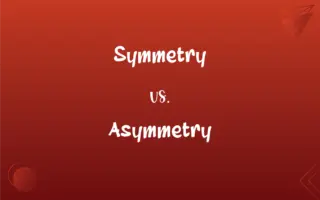Gross Profit Margin vs. Net Profit Margin: What's the Difference?
Copy edited by Aimie Carlson || By Janet White || Published on November 18, 2023
Gross Profit Margin represents the percentage of sales exceeding the cost of goods sold, while Net Profit Margin denotes the percentage of profit after all expenses are deducted from sales.

Key Differences
Gross Profit Margin is a financial metric that showcases a company's financial health by measuring the proportion of money left from sales after deducting the cost of goods sold. This margin focuses specifically on the relationship between sales and the direct costs associated with producing the goods or services sold by a company. On the other hand, Net Profit Margin goes a step further, taking into account not only the cost of goods sold but all other expenses as well, including operational, administrative, and other costs. It provides a more holistic view of a company's profitability, as it gives the percentage of each dollar of revenue that translates into net profit.
Gross Profit Margin serves as a preliminary measure of profitability, offering insights into how efficiently a company produces its goods. It essentially gauges the effectiveness of production processes and the pricing strategy. However, Net Profit Margin is often seen as a more comprehensive measure of profitability. It considers all the costs that a company incurs, not just those related to production. By comparing Gross Profit Margin and Net Profit Margin, stakeholders can understand where the company's expenses lie, whether in production or operations.
When Gross Profit Margin is high, it can suggest that a company is effective in managing its production or direct service costs. However, a high Gross Profit Margin does not always translate into high profitability if the company's operational costs are elevated. In such cases, the Net Profit Margin may be significantly lower, reflecting those added costs. Thus, while Gross Profit Margin may highlight the core profitability of sales, Net Profit Margin paints a fuller picture, emphasizing the company's efficiency in managing both production and operational expenses.
Both Gross Profit Margin and Net Profit Margin play critical roles in financial analysis. While Gross Profit Margin offers insights into the efficiency of the production or service delivery process, Net Profit Margin showcases the overall profitability, factoring in all expenses. Both metrics are pivotal for investors, creditors, and management to understand the profitability and financial health of a business.
Comparison Chart
Components
Sales - Cost of Goods Sold.
Sales - All Expenses (including COGS, operational, etc.)
ADVERTISEMENT
Reflects
Efficiency in production.
Overall profitability.
Scope
Focuses on production or direct service costs.
Considers all operational costs.
Interpretation
Higher value indicates effective cost management.
Higher value indicates higher overall profitability.
Usage
Preliminary measure of profitability.
Comprehensive measure of profitability.
Gross Profit Margin and Net Profit Margin Definitions
Gross Profit Margin
Gross Profit Margin measures profitability before operational and other expenses.
Their Gross Profit Margin was robust, highlighting strong sales and controlled production expenses.
ADVERTISEMENT
Net Profit Margin
Net Profit Margin reveals the percentage of revenue left after all expenses.
Despite strong sales, the company's low Net Profit Margin highlighted higher overhead costs.
Gross Profit Margin
Gross Profit Margin reveals the percentage of revenue exceeding direct production costs.
An increasing Gross Profit Margin suggests better cost management in manufacturing.
Net Profit Margin
Net Profit Margin measures how effectively a company converts revenue into actual profit.
A consistent Net Profit Margin indicates stable financial management across all departments.
Gross Profit Margin
Gross Profit Margin is the ratio of gross profit to sales revenue.
A high Gross Profit Margin indicates the company maintained low production costs.
Net Profit Margin
Net Profit Margin gauges the portion of sales translating into net profit.
Even with strong sales, a narrow Net Profit Margin can be concerning for investors.
Gross Profit Margin
Gross Profit Margin reflects the portion of each sales dollar remaining after deducting cost of goods sold.
The company's Gross Profit Margin of 40% suggests 40 cents from every dollar remain after direct costs.
Net Profit Margin
Net Profit Margin is the ratio of net profit to sales revenue, expressing overall profitability.
A declining Net Profit Margin could signal increasing operational costs.
Gross Profit Margin
Gross Profit Margin indicates the efficiency of production in relation to sales.
The firm's impressive Gross Profit Margin demonstrates its effective production strategies.
Net Profit Margin
Net Profit Margin provides insights into a firm's efficiency after factoring in all costs.
The 25% Net Profit Margin means the company retains 25 cents from every sales dollar as profit.
FAQs
How does Net Profit Margin differ from Gross Profit Margin?
Net Profit Margin considers all expenses, providing an overall profitability measure, while Gross Profit Margin focuses on production costs.
Which margin provides a comprehensive view of profitability?
Net Profit Margin offers a more comprehensive view, factoring in all expenses.
Can a company have a high Gross Profit Margin but a low Net Profit Margin?
Yes, if a company has high operational or other non-production expenses, it can impact the Net Profit Margin.
What can erode Net Profit Margin?
High operational costs, interest expenses, or other non-production costs can erode Net Profit Margin.
Can a company be profitable with a low Net Profit Margin?
Yes, especially if it operates on high volume and turnover, like some retailers.
What does a high Gross Profit Margin signify?
A high Gross Profit Margin indicates effective management of production or direct service costs.
Why is Gross Profit Margin important for manufacturers?
Gross Profit Margin helps manufacturers assess efficiency in production and cost management.
Is it possible for Net Profit Margin to be negative?
Yes, a negative Net Profit Margin indicates that expenses exceeded revenues.
How can one improve Gross Profit Margin?
Improving production efficiency, reducing costs, or increasing prices can enhance Gross Profit Margin.
Is a higher Gross Profit Margin always better?
Generally, a higher Gross Profit Margin is preferable, but it should also be compared with industry norms.
How is Net Profit Margin calculated?
Net Profit Margin is calculated by dividing net profit by sales revenue and multiplying by 100.
How can a company improve its Net Profit Margin?
Reducing operational costs, increasing sales, or managing debts effectively can boost Net Profit Margin.
Is a consistent Net Profit Margin a good sign?
A consistent Net Profit Margin indicates stable profitability and effective cost management.
Is Net Profit Margin an indicator of a company's financial health?
Yes, a consistently high Net Profit Margin indicates strong financial health and management.
Why might a service company focus on Gross Profit Margin?
Service companies, without tangible goods, might focus on Gross Profit Margin to assess the cost efficiency of their services.
Can Gross Profit Margin be negative?
Yes, if the cost of goods sold exceeds sales revenue, Gross Profit Margin can be negative, indicating a loss on goods sold.
Can Gross Profit Margin and Net Profit Margin be the same?
If a company has no other expenses beyond the cost of goods sold, both margins can be identical.
What affects the Gross Profit Margin?
Production costs, pricing strategy, and sales volume can impact Gross Profit Margin.
Can both Gross Profit Margin and Net Profit Margin be used for forecasting?
Yes, both can provide insights into future profitability based on historical data.
Which margin is more sensitive to changes in sales?
Gross Profit Margin is more directly sensitive to sales and production cost changes.
About Author
Written by
Janet WhiteJanet White has been an esteemed writer and blogger for Difference Wiki. Holding a Master's degree in Science and Medical Journalism from the prestigious Boston University, she has consistently demonstrated her expertise and passion for her field. When she's not immersed in her work, Janet relishes her time exercising, delving into a good book, and cherishing moments with friends and family.
Copy edited by
Aimie CarlsonAimie Carlson, holding a master's degree in English literature, is a fervent English language enthusiast. She lends her writing talents to Difference Wiki, a prominent website that specializes in comparisons, offering readers insightful analyses that both captivate and inform.






































































